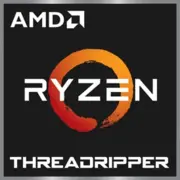AMD Ryzen Threadripper 2920X

AMD Ryzen Threadripper 2920X: A Guide to the Legendary 12-Core Processor in 2025
Updated: April 2025
Key Features: Architecture, Performance, and Unique Traits
The AMD Ryzen Threadripper 2920X, released in 2018, remains in demand on the secondary market due to its multithreading power. Despite its age, its Zen+ architecture on a 12nm process demonstrates stability under workloads.
- Cores and Threads: 12 cores / 24 threads.
- Cache: 32 MB L3 — sufficient for data processing in rendering and virtualization.
- Clock Speeds: Base — 3.5 GHz, maximum turbo — 4.3 GHz.
- TDP: 180W — requires efficient cooling.
- Performance: In Geekbench 6 (2025) — 1266 (single-core) and 7493 (multi-core). In comparison, the modern Ryzen 5 7600X scores around ~2200/11000, but the Threadripper shines in multitasking.
Key Features:
- Support for Quad Channel DDR4 — up to 1 TB of RAM.
- 64 PCIe 3.0 lanes — capability to connect multiple GPUs or NVMe drives.
- TR4 socket — unique design for enthusiasts.
Compatible Motherboards: Sockets and Chipsets
The Threadripper 2920X uses the TR4 socket, supported by X399 chipsets. As of 2025, new boards for this socket are no longer manufactured, but they can be found in stock or from specialized sellers.
Selection Recommendations:
- ASUS ROG Zenith Extreme X399: A reliable model featuring advanced VRM and Wi-Fi 6. Price in 2025 — starting from $250 (new units are rare).
- GIGABYTE X399 AORUS Xtreme: Supports 10 Gigabit Ethernet and 3x M.2 slots.
Important: Due to the large size of motherboards (E-ATX format), check for compatibility with your case.
Supported Memory: DDR4 and Overclocking
The Threadripper 2920X works only with DDR4. There is no compatibility with DDR5 due to architectural limitations.
- Official Support: DDR4-2933 MHz.
- Recommended Modules: 4 or 8 sticks of 8/16 GB to activate Quad Channel. For example, G.Skill Trident Z RGB 3200 MHz — overclocking to 3400 MHz is possible with manual timing adjustments.
Tip: For stability, avoid memory with frequencies above 3600 MHz — the CPU controller may struggle.
Power Supply Units: Power Calculation and Recommendations
With a TDP of 180W and power consumption during overclocking, the Threadripper 2920X requires a quality PSU.
- Minimum Power: 600W (for a system with one GPU at the RTX 4070 level).
- Recommended: 750–850W. For example, Corsair RM850x (2025) with 80+ Gold efficiency and a 10-year warranty ($130–150).
Note: If using multiple GPUs or NVMe RAID arrays, opt for a 1000W PSU.
Pros and Cons of the Threadripper 2920X in 2025
Pros:
- Price: New processors (if available) — $300–400, which is cheaper than modern 12-core processors ($500+).
- Multithreading: 24 threads are relevant for rendering in Blender or compiling code.
- Scalability: 64 PCIe 3.0 lanes for professional tasks.
Cons:
- Outdated process: 12nm versus 5–7nm in Ryzen 7000/8000.
- No PCIe 4.0/5.0: NVMe SSD speed is limited to 3.5 GB/s.
- Energy efficiency: New processors (e.g., Ryzen 9 7900X) can deliver twice the performance at 170W.
Use Cases: Where the 2920X is Still Relevant
1. Workstations:
- 3D rendering, video editing in DaVinci Resolve.
- Virtualization (VMware, Proxmox) — 24 threads allow for running dozens of virtual machines.
2. Server Tasks:
- Local NAS with ZFS and hardware RAID.
3. Gaming:
- Not the best choice in 2025. In games (e.g., Cyberpunk 2077 Phantom Liberty), it lags behind even the Ryzen 5 7600X due to low single-thread performance.
Real Example: A YouTube video editor using the 2920X notes that rendering a 4K video takes 12 minutes, compared to 8 minutes on the Ryzen 9 7900X, but the processor was purchased for $280 versus $550 for the newer equivalent.
Comparison with Competitors
- Intel Core i9-10900X (Cascade Lake-X):
- 10 cores / 20 threads, L3 19 MB.
- Falls short in multithreaded tasks (~6500 in Geekbench 6 Multi).
- Price: $350 (new, remaining stock).
- AMD Ryzen 9 5900X:
- 12 cores / 24 threads, but for the AM4 platform.
- Better in gaming (+30% Single-Core), but weaker in multithreading due to lack of Quad Channel.
Building Tips
1. Cooling: Coolers like Noctua NH-U14S TR4-SP3 or AIO NZXT Kraken X63 (with TR4 adapter).
2. Case: Choose models that support E-ATX (e.g., Lian Li PC-O11 Dynamic).
3. Motherboard: Check for BIOS updates for compatibility with new SSDs and GPUs.
Pitfall: Some older X399 motherboards do not support NVMe SSDs larger than 2 TB.
Conclusion: Who Should Consider the Threadripper 2920X in 2025?
This processor is worth considering for:
- Budget Professionals: Freelancers, video editors, developers needing 12 cores for $300.
- Upgrade Enthusiasts: If you already have an X399 board and DDR4, the 2920X can breathe new life into your system.
Not Recommended: Gamers and those needing PCIe 4.0/5.0 drives.
Final Note: Despite its age, the Threadripper 2920X remains a workhorse for specific tasks. Its price/performance ratio in multithreading justifies its value, but only with a wise selection of other components.
Basic
CPU Specifications
Memory Specifications
GPU Specifications
Miscellaneous
Benchmarks
Compared to Other CPU
Share in social media
Or Link To Us
<a href="https://cputronic.com/en/cpu/amd-ryzen-threadripper-2920x" target="_blank">AMD Ryzen Threadripper 2920X</a>